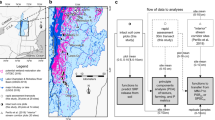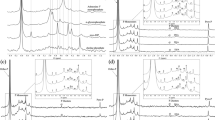Abstract
The recent implementation of agricultural best management practices (BMPs) and treatment wetlands called stormwater treatment areas (STAs) have reduced phosphorus (P) concentrations and loadings to the Everglades Protection Area (EPA) in Florida (USA). There is a concern that despite reductions in external P loadings, internal loading from the legacy P enrichment of the EPA wetland soils will continue to elevate water column P concentrations, and may impede restoration outcomes. In an effort to explore ways to reduce soil P efflux, we retrieved intact, vegetated (cattail, Typha domingensis) soil monoliths from two P-enriched areas of the EPA and deployed them at a location where they received pre-treated (low P) surface water as ex situ flow-through mesocosms for 21 months with a mid-study 7-week dry down to mimic natural hydroperiod conditions. Two treatments were tested for soils from both sites, using triplicate mesocosms for each treatment. After applying a herbicide (glyphosate) to eliminate the cattail vegetation, iron (Fe as liquid FeCl3) amendments provided no P retention benefits in the organic soils from the two sites, and did not yield significantly (P > 0.05; n = 43) lower flux rates (6.1 and 3.5 mg Pm−2 d−1) than the herbicide/no soil amendment control (3.9 and 2.1 mg Pm−2 d−1), as was expected. A combination of low oxidation–reduction potential, heightened organic matter P mineralization, high pH, and sulfide production acted interactively to enhance Fe and P mobilization in the Fe-amended mesocosms. The herbicide/limerock (CaCO3)-amended soils exhibited significantly lower (P ≤ 0.05; n = 43) P flux (1.3 and 1.1 mg Pm−2 d−1) than the herbicide/no soil amendment control soils, but it remains unknown whether the observed reduction in P efflux (ranging from 48 to 67%) would justify the expense and potential environmental impacts of applying a surficial limerock amendment to large regions of the P-enriched wetlands.





Similar content being viewed by others
References
Ann Y, Reddy KR, Delfino JJ (2000) Influence of redox potential on phosphorus solubility in chemically amended wetland and organic soils. Ecol Eng 15:169–180
APHA, AWWA, WEF (1992) Standard methods for the examination of water and wastewater, 18th edn. American Public Health Association, American Water Works Association, Water Environment Federation, Washington, DC
APHA, AWWA, WEF (1998) Standard methods for the examination of water and wastewater, 20th edn. American Public Health Association, American Water Works Association, Water Environment Federation, Washington, DC
ASA (1986) In: Klute A (ed) Methods of Soil Analyses. Part 1. Physical and Mineralogical Methods, 2nd edn. Agron Monogr 9. American Society of Agronomy, Madison
Boers PCM (1991) The release of dissolved phosphorus from lake sediments. Ph.D. thesis, University of Wageningen, the Netherlands
Brezonik PL, Arnold WA (2011) Water chemistry: an introduction to the chemistry of natural and engineered aquatic systems. Oxford University Press, New York
Burns and McDonnell Engineering Company Inc. (2003) Long Term Plan for Achieving Water Quality Goals in the Everglades Protection Area Tributary Basins. Final report submitted to the South Florida Water Management District, West Palm Beach
Chimney MJ, Goforth G (2001) Environmental impacts to the Everglades ecosystem: a historical perspective and restoration strategies. Water Sci Technol 44:93–100
Chimney MJ, Wan Y, Matichenkov VV, Calvert DV (2007) Minimizing phosphorus release from newly flooded organic soils amended with calcium silicate slag: a pilot study. Wetl Ecol Manag 15:385–390
Davis SM (1994) Phosphorus inputs and vegetation sensitivity in the Everglades. In: Davis SM, Ogden JC (eds) Everglades: the ecosystem and Its restoration. Lucie Press, Boca Raton, pp 357–378
Davis SM, Ogden JC (eds) (1994) Everglades: The Ecosystem and Its Restoration. Lucie Press, Boca Raton, p 826
DeBusk WF, Reddy KR (2005) Litter decomposition and nutrient dynamics in a phosphorus enriched Everglades marsh. Biogeochemistry 75:217–240
DeBusk WF, Newman S, Reddy KR (2001) Spatio-temporal patterns of soil phosphorus enrichment in Everglades water conservation area 2A. J Environ Qual 30:1438–1446
DeBusk TA, Grace KA, Dierberg FE, Jackson SC, Chimney MJ, Gu B (2004) An investigation of the limits of phosphorus removal in wetlands: a mesocosm study of a shallow periphyton-dominated treatment system. Ecol Eng 23:1–14
Driscoll CT, Effler SW, Auer MT, Doerr SM, Penn MR (1993) Supply of phosphorus to the water column of a productive hardwater lake: controlling the mechanisms and management considerations. Hydrobiologia 253:61–72
FDEP (2004) Department of Environmental Protection Standard Operating Procedures for Field Activities. DEP-SOP-001/01. Tallahassee, FL. Bureau of Laboratories Environmental Assessment Section. February 1, 2004
Fisher MM, Reddy KR (2001) Phosphorus flux from wetlands soils affected by long-term nutrient loading. J Environ Qual 30:261–271
Geurts JJM, Smolders AJP, Verhoeven JTA, Roelofs JGM, Lamers LPM (2008) Sediment Fe:pO4 ratio as a diagnostic and prognostic tool for the restoration of macrophyte biodiversity in fen waters. Freshwater Biol 53:2101–2116
Gleason PJ, Cohen AD, Brooks HK, Stone P, Goodrick R, Smith WG, Spackman W Jr (1974) The environmental significance of Holocene sediments from the Everglades and saline tidal plain. In: Gleason PJ (ed) Environments of South Florida: present and past II. Miami Geological Society, Miami, pp 287–341
Hagerthey SE, Newman S, Rutchey K, Smith EP, Godin J (2008) Multiple regime shifts in a subtropical peatlands community—specific thresholds to eutrophication. Ecol Monogr 78:547–565
Hagerthey SE, Cook MI, Kobza RM, Newman S, Bellinger BJ (2014) Aquatic faunal responses to an induced regime shift in the phosphorus-impacted Everglades. Freshwater Biol 59:1389–1405
Hoge VR, Conrow R, Coveney M, Peterson J (2003) The application of alum residual as a phosphorus abatement tool within the Lake Apopka Restoration Area. In: Proceedings of the Water Environment Federation, Baltimore, pp 1500-1513
Koch MS, Reddy KR (1992) Distribution of soil and plant nutrients along a trophic gradient in the Florida Everglades. Soil Sci Soc Am J 56:1492–1499
Light TS (1972) Standard solution for redox potential measurements. Anal Chem 44:1038–1039
McCormick PV, O’Dell MB (1996) Quantifying periphyton responses to phosphorus in the Florida Everglades: a synoptic-experimental approach. J N Am Benthol Soc 15:450–468
Miao SL, DeBusk WF (1999) Effects of phosphorus enrichment on structure and function of sawgrass and cattail communities in the Everglades. In: Reddy KR, O’Connor GA, Schelske CL (eds) Phosphorus biogeochemistry in subtropical ecosystems. Lewis Publishers, Boca Raton, pp 274–299
Miao SL, Sklar FH (1998) Biomass and nutrient allocation of sawgrass and cattail along a nutrient gradient in the Florida Everglades. Wetl Ecol Manag 5:245–263
Newman S, Rodgers L, Manna M, Cook M, Coronado-Molina C, Ross M, Madden C, Troxler T, Kelly S, Bennett R, Black D, Sah JP (2013) Chapter 6: ecosystem ecology. In: 2013 South Florida Environmental Report, South Florida Water Management District, West Palm Beach, pp 6–37 to 6–39
Nürnberg G (1984) Iron and hydrogen sulfide interference in the analysis of soluble reactive phosphorus in anoxic waters. Water Res 18:369–377
Proctor DM, Fehling KA, Shay EC, Wittenborn JL, Green JJ, Avent C, Bigham RD, Connolly M, Lee B, Shepker TO, Zak MA (2000) Physical and chemical characteristics of blast furnace, basic oxygen furnace, and electric arc furnace steel industry slags. Environ Sci Technol 34:1576–1582
Reddy KR, DeLaune RD (2008) Biogeochemistry of wetlands: science and applications. CRC Press, Taylor & Francis Group, Boca Raton
Reddy KR, Wang Y, DeBusk WF, Fisher MM, Newman S (1998) Forms of soil phosphorus in selected hydrologic units of the Florida Everglades. Soil Sci Soc Am J 62:1134–1147
Reeder PB, Davis SM (1983) Decomposition, nutrient uptake and microbial colonization of sawgrass and cattail leaves in water conservation area 2A. Technical Publication 83-4, South Florida Water Management District, West Palm Beach
Plumb Jr. RH (1981) Procedures for handling and chemical analysis of sediment and water samples. In: Technical Report EPA. COE-81-1. Criteria for Dredged and Fill Material. USEPA/US Army Corps of Engineers. US Army Engineer Waterways Experiment Station, Vicksburg
Richardson CJ (2008) An ecological approach for restoration of the Everglades fen, Chapter 26. In: Richardson CJ (ed) The everglades experiments: lessons for ecosystem restoration. Springer Science+Business Media, LLC, New York
Richardson CJ, Pahl JW, Vymazal J, Vaithiyanathan P, Qualls RG, Sundareshwar PV, Barber ML, Johnson J (2008) Enrichment gradients in WCA-2A and northern WCA-3A: Soil, plant biomass, and nutrient storage responses, Chapter 6. In: Richardson CJ (ed) The everglades experiments: lessons for ecosystem restoration. Springer Science+Business Media, LLC, New York
Sherwood LJ, Qualls RG (2001) Stability of phosphorus within a wetland soil following ferric chloride treatment to control eutrophication. Environ Sci Technol 35:4126–4131
Smolders AJP, Nijboer RC, Roelofs JGM (1995) Prevention of sulphide accumulation and phosphate mobilization by the addition of iron(II) chloride to a reduced sediment: an enclosure experiment. Freshwater Biol 34:559–568
Smolders AJP, Lamers LPM, Moonen M, Zwaga K, Roelofs JGM (2001) Controlling phosphate release from phosphate-enriched sediments by various iron compounds. Biogeochemistry 54:210–228
Statsoft, Inc. (2010) STATISTICA (data analysis software system), version 9.1
Stober QJ, Thornton K, Jones R, Richards J, Ivey C, Welch R, Madden M, Trexler J, Gaiser E, Scheidt D, Rathbun S (2001) South Florida ecosystem assessment: Phase I/II (Technical Report)- everglades stressor interactions: hydropatterns, eutrophication, habitat alternation, and mercury contamination. U.S. Environmental Protection Agency, Region 4, EPA 904-R-01-003, Georgia
USEPA (1999) Methods and Guidance for the Analysis of Water. Version 2. June 1999. United States Environmental Protection Agency, Washington, DC
White JR, Reddy KR, Moustafa MZ (2004) Influence of hydrologic regime and vegetation on phosphorus retention in Everglades stormwater treatment area wetlands. Hydrol Process 18:343–355
Zak D, Gelbrecht J, Steinberg CEW (2004) Phosphorus retention at the redox interface of peatlands adjacent to surface waters in northeast Germany. Biogeochemistry 70:357–368
Zak D, Wagner C, Payer B, Augustin J, Gelbrecht J (2010) Phosphorus mobilization in rewetted fens: the effect of altered peat properties and implications for their restoration. Ecol Appl 20:1336–1349
Acknowledgements
Sample analyses were performed by J. Henry, N. Chan, K. Hileman, N. Larson, L. Colville, J. Wolack, and S. O’Harrow. J. Potts undertook the statistical analyses. T. Goffinet and D. Haselow helped core and transport the soil monoliths from WCA-2A to the experimental site (SATTS).
Funding
Funding was provided by the Everglades Agricultural Area Environmental Protection District.
Author information
Authors and Affiliations
Corresponding author
Electronic supplementary material
Below is the link to the electronic supplementary material.
Rights and permissions
About this article
Cite this article
Dierberg, F.E., DeBusk, T.A., Jackson, S.D. et al. An assessment of iron and calcium amendments for managing phosphorus release from impacted Everglades soils. Wetlands Ecol Manage 25, 649–666 (2017). https://doi.org/10.1007/s11273-017-9542-2
Received:
Accepted:
Published:
Issue Date:
DOI: https://doi.org/10.1007/s11273-017-9542-2




